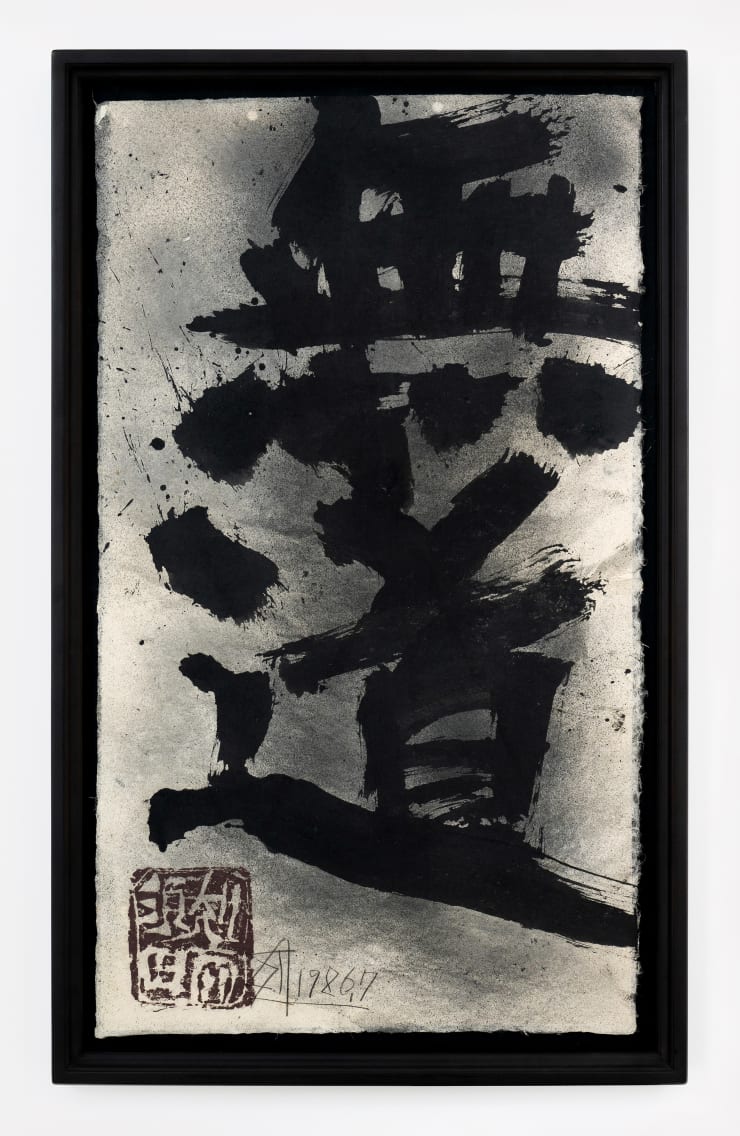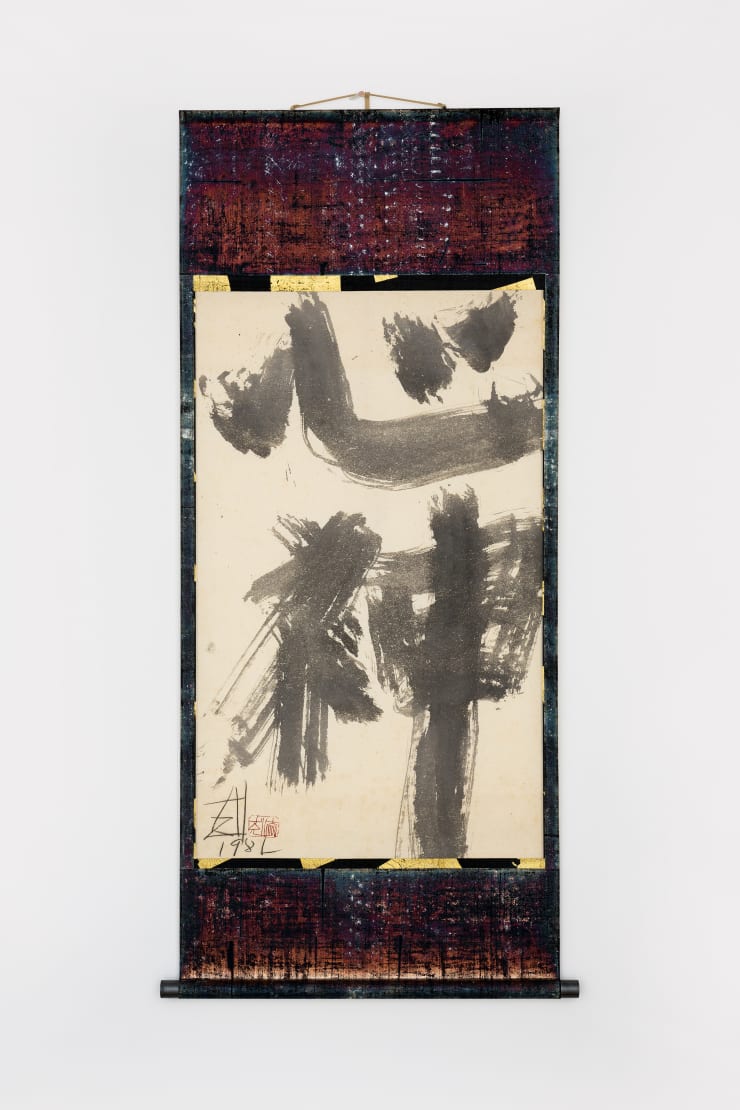Kokuta Suda: Okukō 憶劫
Nonaka-Hill is pleased to present Kokuta Suda: Okukō, the first American solo gallery exhibition for the artist. Suda (須田 剋太, 1906-1990) was a pioneer for merging abstraction and calligraphy, for his raw spontaneity with various media; and for maximizing their tactile potentials with embossing, impasto, and even affixed stones. His paintings and works on paper do not pull us into pictorial space as much as affirm their objecthood: they are records of physical phenomena born at the junction between chance, intervention, and material.
A difficult artist to categorize by virtue of his shifting practices, Suda worked in figuration for twenty years before transitioning to abstraction in the 1950s. In 1952, he founded Genbi (Modern Art Discussion Group), which included Jiro Yoshihara (1905-1972), the future leader of Gutai. Yoshihara later invited Suda to join Gutai, but he declined, choosing to forge his own path instead; this included several shifts in style over the decades, including a lasting engagement with calligraphy and re-engagement with figuration.
By contrast, Suda’s abstractions on view from the early 1960s have a worn and handled quality devoid of line-work. Which is to say, the paper supports were perforated, scarred, scratched, or even shaped atop stones and other objects, a form of embossing. The paint was slathered, washed on, or wiped into the crevices of the paper; and it was mixed with earthen materials like lithic flake (rock shavings), minerals, and metallics. His works thus have organic appearances, weathered and self-inducing. They were eruptions from Suda’s being as it catalyzed the interaction of pigment, stones, and minerals.
These effects were partly owed to Suda’s deep commitment to Zen Buddhism, which influenced his life and work philosophy (to such a degree, apparently, that he was referred to as Kyoojin Kokuta, or “Madman Kokuta” by a colleague). His paintings were thus emphatically invested in the unfoldment of natural phenomena and minutae as it filtered through his hands. He allowed materials to commingle and alchemize into a third form of representation, independent of external appearances and his “inner world.”
A work from 1958 titled Active Nothing-Like Thing, encapsulates his ethos (and the contradictions of Zen Buddhism): he sought to activate nothing into a thing. This dovetailed with the idea of the kokoro, which means “heart” or “soul” or “thought,” the essence of a thing. As the kokoro is the “psychometaphysical aspect of the inward way,” to quote Buddhist scholar D.T. Suzuki (1870-1966), it is not something readily identifiable: It is the abyss from which all things emerge and return. One might think of Suda’s paintings in this manner, as outward manifestations of spontaneous becoming from nothing. As such, they do not yield to any precise meaning, structure, or art historical narrative. Fittingly, the character koku 剋, which translates to “overturn” or “upheaval” is the same character he used to sign his paintings, nodding to the underlying philosophy that made his work alluring yet slippery to our cognition.
-
 Kokuta SudaOkuko 憶劫, 1988Ink, silver paint on paper, framed43 1/2 x 58 5/8 in (110.6 x 149 cm)
Kokuta SudaOkuko 憶劫, 1988Ink, silver paint on paper, framed43 1/2 x 58 5/8 in (110.6 x 149 cm)
45 1/4 x 60 1/4 in framed (115 x 153 cm framed) -
 Kokuta SudaBudo (roughshod, savage) 無道, 1986Ink, silver paint on paper, framed38 1/4 x 22 in (56 x 97 cm)
Kokuta SudaBudo (roughshod, savage) 無道, 1986Ink, silver paint on paper, framed38 1/4 x 22 in (56 x 97 cm)
41 3/4 x 25 5/8 in framed (106 x 65 cm framed) -
 Kokuta SudaShinshin 心神, 1981Ink on paper, hanging scroll33 7/8 x 20 7/8 in (86 x 53 cm)
Kokuta SudaShinshin 心神, 1981Ink on paper, hanging scroll33 7/8 x 20 7/8 in (86 x 53 cm)
52 3/4 x 22 7/8 in framed (134 x 58 cm framed) -
 Kokuta SudaAbstraction 抽象, 1970Oil on canvas64 x 51 5/8 in (162.5 x 131 cm)
Kokuta SudaAbstraction 抽象, 1970Oil on canvas64 x 51 5/8 in (162.5 x 131 cm) -
 Kokuta SudaAbstraction 抽象Gouache, pastel and mineral colors on paper, framed29 1/8 x 23 1/4 in (74 x 59 cm)
Kokuta SudaAbstraction 抽象Gouache, pastel and mineral colors on paper, framed29 1/8 x 23 1/4 in (74 x 59 cm)
31 3/8 x 25 5/8 in framed (79.6 x 65 cm framed) -
 Kokuta SudaAbstraction 抽象, 1960Oil, mineral colors and lithic flake on paper28 3/4 x 24 in (73 x 61 cm)
Kokuta SudaAbstraction 抽象, 1960Oil, mineral colors and lithic flake on paper28 3/4 x 24 in (73 x 61 cm)
29 3/8 x 24 1/2 in framed (74.6 x 62.2 cm framed) -
 Kokuta SudaAbstraction 抽象, c. 1959Oil on canvas, framed23 1/4 x 19 1/8 in (59 x 48.5 cm)
Kokuta SudaAbstraction 抽象, c. 1959Oil on canvas, framed23 1/4 x 19 1/8 in (59 x 48.5 cm)
30 1/2 x 26 3/8 in framed (77.5 x 67 cm framed) -
 Kokuta SudaAbstraction 抽象, 1961Oil on canvas, framed21 1/4 x 18 1/8 in (54 x 46 cm)
Kokuta SudaAbstraction 抽象, 1961Oil on canvas, framed21 1/4 x 18 1/8 in (54 x 46 cm)
22 1/2 x 19 1/4 in framed (57 x 49 cm framed) -
 Kokuta SudaAbstraction 抽象, 1968Gouache on paper, framed45 1/4 x 35 3/8 in (115 x 90 cm)
Kokuta SudaAbstraction 抽象, 1968Gouache on paper, framed45 1/4 x 35 3/8 in (115 x 90 cm)
46 7/8 x 37 in framed (119 x 94 cm framed) -
 Kokuta SudaWork 作品, 1963Oil and duralumin pigment on dungaree, framed46 1/2 x 32 1/4 in (118 x 82 cm)
Kokuta SudaWork 作品, 1963Oil and duralumin pigment on dungaree, framed46 1/2 x 32 1/4 in (118 x 82 cm)
48 x 33 7/8 in framed (122 x 86 cm framed) -
 Kokuta SudaActive Nothing-Like Thing 能動的無的主体, 1958Pastel, gouache and pencil on paper, framed12 5/8 x 9 7/8 in (32 x 25 cm)
Kokuta SudaActive Nothing-Like Thing 能動的無的主体, 1958Pastel, gouache and pencil on paper, framed12 5/8 x 9 7/8 in (32 x 25 cm)
13 3/8 x 10 5/8 in framed (34 x 27 cm framed) -
 Kokuta SudaAbstraction 抽象Gouache on paper, framed30 x 23 3/8 in (76.1 x 59.3 cm)
Kokuta SudaAbstraction 抽象Gouache on paper, framed30 x 23 3/8 in (76.1 x 59.3 cm)
30 1/4 x 24 in framed (77 x 61 cm framed) -
 Kokuta SudaAbstraction 抽象, 1961Oil on canvas, framed28 3/4 x 24 in (73 x 61 cm)
Kokuta SudaAbstraction 抽象, 1961Oil on canvas, framed28 3/4 x 24 in (73 x 61 cm)
31 1/2 x 26 3/4 in framed (80 x 68 cm framed) -
 Kokuta SudaAbstraction 抽象, 1953Gouache and collage on paper, framed17 3/4 x 14 3/4 in (45.2 x 37.3 cm)
Kokuta SudaAbstraction 抽象, 1953Gouache and collage on paper, framed17 3/4 x 14 3/4 in (45.2 x 37.3 cm)
20 1/8 x 16 7/8 in framed (51 x 43 cm framed) -
 Kokuta SudaAbstraction 抽象Oil on canvas, framed28 3/4 x 23 7/8 in (73 x 60.5 cm)
Kokuta SudaAbstraction 抽象Oil on canvas, framed28 3/4 x 23 7/8 in (73 x 60.5 cm)
29 3/4 x 24 3/4 in framed (75.5 x 63 cm framed) -
 Kokuta SudaAbstraction 抽象Gouache, mineral colors and duralumin pigment on paper, framed14 5/8 x 11 3/4 in (37 x 30 cm)
Kokuta SudaAbstraction 抽象Gouache, mineral colors and duralumin pigment on paper, framed14 5/8 x 11 3/4 in (37 x 30 cm) -
 Kokuta SudaInfinite Space 無限空間, c. 1959Oil and collage on canvas, framed28 3/8 x 19 3/4 in (72 x 50 cm)
Kokuta SudaInfinite Space 無限空間, c. 1959Oil and collage on canvas, framed28 3/8 x 19 3/4 in (72 x 50 cm)
35 7/8 x 27 1/8 in framed (91 x 69 cm framed) -
 Kokuta SudaDaito 大燈, 1989Ink on paper, hanging scroll34 5/8 x 18 1/2 in (88 x 47 cm)
Kokuta SudaDaito 大燈, 1989Ink on paper, hanging scroll34 5/8 x 18 1/2 in (88 x 47 cm)
49 1/4 x 19 1/4 in framed (125 x 49 cm framed) -
 Kokuta SudaKado (the art of flower arrangement) 華道 , 1989Ink on paper, hanging scroll37 3/4 x 22 7/8 in (96 x 58 cm)
Kokuta SudaKado (the art of flower arrangement) 華道 , 1989Ink on paper, hanging scroll37 3/4 x 22 7/8 in (96 x 58 cm)
51 5/8 x 23 5/8 in framed (131 x 60 cm framed)




















